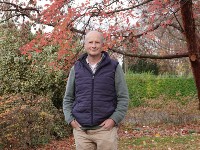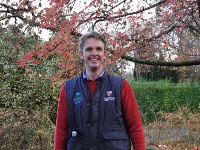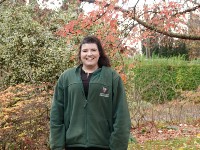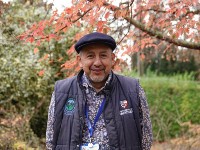Meet the team
Our mission is to promote an appreciation of the beauty, diversity and importance of plants, and an understanding of their role in the natural world.
- Education
-
Cruickshank Botanic Garden is an inclusive resource for the breadth of subjects taught across the University of Aberdeen, encompassing both the arts and sciences combined. While the Living Collection has immediate practical benefits in the teaching of specific disciplines in the School of Biological Sciences - as per the degree programmes listed below - the Schools of Education, English, Anthropology, Geography and Medicine regularly use the Botanic Garden for teaching and demonstration purposes.
The School offers a number of degree programmes including Plant and Soil Science, Ecology, Conservation Biology and Environmental Science.
The Botanic Garden is valued and extensively used by the Aberdeen Biodiversity Centre - the University's schools education outreach centre - situated in the Zoology Building, on the western flank of the garden. The Centre was established in 1995 and aims to engage local school children, communities and the general public in creative education programmes, with an emphasis on outdoor provision.
Our history
- Donation of Land
-
There have been gardens and parkland on the present site since from at least the late 17th Century. Gordon's 1647 map of Old Aberdeen shows 'Clunys Garden' lying between the then Old Aberdeen Loch and St Machar's Kirk.
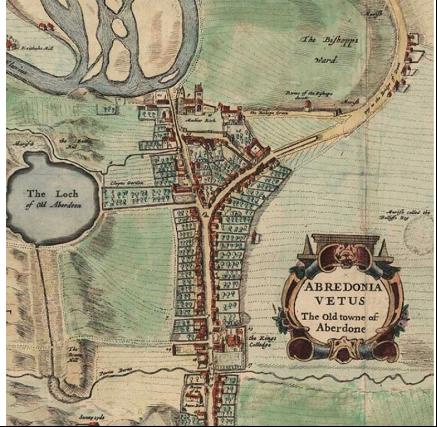
'Abredoniae novae et veteris descriptio'. Surveyed by James Gordon in 1647
The modern Garden was established in 1898, when Miss Anne Cruickshank bought the buildings and playing fields of The Old Aberdeen Gymnasium, a private school for boys, and presented them to the University to establish a Botanic Garden and the Cruickshank Garden Trust. The original granite school building, now part of the School of Biological Sciences - with an emphasis on the teaching of botanic subjects - is on the right as you enter the Garden from The Chanonry.
The original donation by Anne Cruickshank of 2.8 hectares (7-acres) in the 1960's was expanded to the present size of 4.5 hectares (11-acres) with the University buying additional land at the northern extreme. This additional land provided space to extend the botanic collection in the form of an Arboretum. Remaining intact, this northern section of the property visually leads into the southern boundary of Seaton Park.
- The Inception - Traill, Craib and Matthews
-
The first Keeper of the Garden was James Traill FRS. The garden was laid out, as was the fashion at the time, in formal beds, but little of the original Garden survives, as it was entirely turned over to vegetables during the First World War. Traill's successor, James Craib, planted many of the fine trees which grace the Garden, and laid out the long herbaceous border while still forms a main axis in the design. Craib also extended the excavation of the sunken garden, with formal terraces and a rose pergola. After the Second World War the new Keeper, J.R.Mathews, and his Head Gardener, James Robb transformed the sunken garden with stone edged beds and paths and established the collection of rhododendrons and dwarf conifers which are a fine feature of the Garden today.
- Further Expansion - 1960s - 1980s
-
The next major developments in the Garden came with the appointment of N.M Pritchard as Curator in 1964. Pritchard was a great plantsman and with successive Head Gardeners, Fred Sutherland and Bob Rutherford, was responsible for the design and planting of the current Garden over 15 years of University expansion and comparative affluence. A new entrance courtyard was created, with paving and peat beds, along with fine order beds (now unfortunately grassed over), and the arboretum was planted with native trees and cultivars along with exotic species of horticultural and forestry importance. In 1968 a bequest from the estate of Baillie James Mackie enabled over 250 tons of Old Red Sandstone to be imported to create a new rock and water garden.
In 1976 the patio and dwarf walls on the south side of the old red brick wall were built and make a popular suntrap, with benches around a fine collection of old stone troughs. Finally, in 1980 the rose garden was created, using monies from the Lautit Bequest and the Stanley Smith Foundation.
- The Cruickshank Trust
-
Miss Cruickshank' original bequest was established as a Charitable Trust that still owns about half of the land incorporated in the Garden, including the original Cruickshank Building, which now forms part of the School of Biological Sciences.
The Trustees contribute financially to the upkeep of the Garden as circumstances permit, but in practice the main burden of the upkeep of the Garden has always been assumed by the University, who maintain the fabric and pay the staff.

